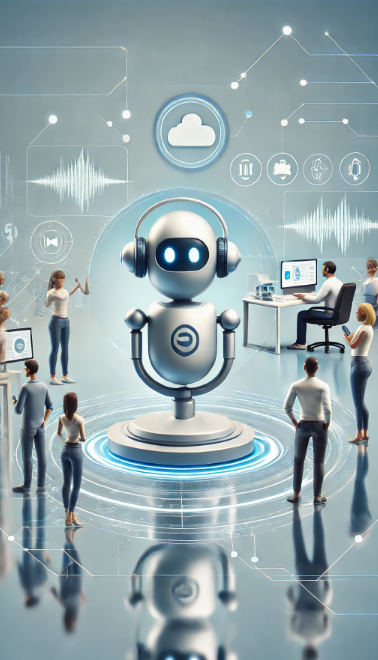Voicebot: Your Key to Efficient Customer Contact

In a world where customer contact increasingly takes place through digital channels, voicebots can play a crucial role in improving customer service.
In this article, you’ll learn what a voicebot is, how this technology works, and the benefits it offers for customer contact. We’ll also discuss the differences between voicebots and traditional chatbots.
Additionally, you’ll discover the applications of voicebots in customer service and get best practices for successful implementation in your organization!
What is a Voicebot?
A voicebot is a virtual voice assistant — in the cloud — that can convert speech to text and vice versa. This allows computers to understand what you’re saying over the phone.
By leveraging artificial intelligence and technologies like Natural Language Processing (NLP, or natural language processing) and text-to-speech (T2S), voicebots can understand spoken queries and respond appropriately.
The key feature of voicebots is their ability to quickly and efficiently understand customer intent from speech. This is now possible thanks to NLP techniques, which were not available in earlier telephony platforms.
This makes modern voicebots highly suitable for automating (among other things) customer contact, enabling businesses to assist their customers better and faster.
In the future, a significant portion of customer contact will be handled entirely or partially by these bots. It’s important to determine what a voicebot excels at and where human interaction and skills are still needed.
How Does a Voicebot Work?
Voicebots use Natural Language Processing (NLP) to understand and analyze speech. They convert speech to text and then analyze the text to generate the appropriate solutions or answers.
When you call a phone number connected via Belfabriek, we can forward the audio during the call to an NLP platform. Some well-known platforms include OpenAI, AzureAI, and Google Dialogflow.
There are also specialized NLPs, such as Deepgram, which focus on accurately understanding specific terms, like medical terminology. For instance, Deepgram can excel at converting a conversation about a medical topic (patient) into text and interpreting it. Very useful!
A well-configured voicebot can easily answer questions, ask follow-up questions to clarify uncertainties, or redirect customers to human agents or the appropriate department. Voicebots can retrieve and process relevant data in real-time, ensuring a faster and more efficient customer experience.
It’s essential to determine what the voicebot can automate at the beginning of the conversation (e.g., collecting customer details, verifying a code, or identifying the topic of the call). This reduces the workload for human agents.
Thanks to machine learning, voicebots can continuously learn from previous interactions, optimizing their responses over time. They become increasingly accurate in recognizing patterns, improving customer interactions.
Voicebots vs. Chatbots
A chatbot is also a virtual assistant, but it communicates with users via text. Voicebots and chatbots are both powerful tools for customer contact, but they differ in several key ways.
- While chatbots are text-based, voicebots communicate through speech. This makes voicebots much more useful, as consumers can speak naturally to them without typing. Research shows that people prefer talking over typing.
- Voicebots can respond faster than chatbots because they process speech instantly.
- Thanks to advanced speech recognition, voicebots can understand more complex commands and instructions, leading to more efficient and effective customer service.
- Additionally, voicebots can better address emotions through their voice-driven interaction. This makes them particularly suitable for scenarios where a personal touch is important, such as in healthcare or customer service. For example, a voicebot can detect when a user becomes angry and transfer the call to a human agent to maintain a positive interaction.
These advantages make voicebots a valuable addition to existing customer contact technologies.
Benefits of Using a Voicebot
Compared to chatbots and conversational IVR (Interactive Voice Response), voicebots offer several advantages that can significantly enhance customer service.
- 24/7 Support: One of the biggest advantages of voice technology is the 24/7 support it provides. Customers can get answers to their questions at any time without waiting. This greatly improves customer service accessibility and reduces wait times.
- Shorter Calls: Voicebots can reduce the time customers spend on calls by quickly answering common questions. This leads to higher customer satisfaction as customers are helped faster. Voicebots can also proactively communicate with customers for reminders and updates.
- Fast Service: By using voicebots, companies can save costs and scale their customer service capabilities effectively. Voicebots can quickly retrieve customer data and provide immediate answers before connecting them to an agent, reducing response times and improving overall customer service efficiency.
- Addressing Emotions: Voicebots enable hands-free interaction, allowing customers to ask questions without using their hands. They can understand complex commands and instructions, and their voice-driven interaction allows them to better address customer emotions. While the voicebot handles incoming calls, employees can focus on other tasks.
Applications of Voicebots in Customer Service
Voicebots are increasingly used in various sectors to effectively address customer inquiries.
In the utilities sector, voicebots are used to efficiently manage high volumes of customer inquiries.
Insurance companies use voicebots to provide immediate answers about policies, renewal dates, and claims.
In the banking sector, institutions use voicebots to analyze customer service interactions and predict future behaviors that may lead to defaults.
Telecom companies deploy voicebots as advisors to guide customers toward the best choices.
Implementing a Voicebot in Your Organization
Implementing a voicebot in your organization starts with leveraging existing data and a knowledge base to effectively resolve customer inquiries. It’s crucial to identify frequently asked questions and limit the scope of possible queries to ask clarifying questions. This applies to an inbound voicebot that handles incoming calls.
For an outbound voicebot, it’s important to determine what the bot should say when calling someone, such as: “Good afternoon, am I speaking with Rick? I see you have outstanding invoices.”
Conclusion
Voicebots offer numerous benefits for improving customer contact. They provide fast, consistent, and personalized interactions, leading to higher customer satisfaction and efficiency. By implementing voicebots, companies can scale and enhance their customer service capabilities cost-effectively.
With the right strategy and implementation, voicebots can be a valuable addition to any customer service. Automation is generally appreciated when it’s both fast and personal. Consider deploying voicebots to improve your customer contact and meet the ever-changing needs of your customers!
Frequently asked questions
A quick way to explore how everything works and what to expect.
A traditional voice response IVR works with pre-recorded menus and options, while a voicebot uses AI and NLP to understand and respond to natural speech. This enables relevant conversations and significantly improves the customer experience.
Yes, modern voicebots can understand complex questions thanks to advanced NLP technologies. They can grasp context, ask follow-up questions, and retrieve relevant information from various sources to provide accurate answers.
No, voicebots can be beneficial for companies of all sizes. They can help automate routine inquiries, reduce employee workload, and improve overall customer service efficiency.
Yes, thanks to the latest techniques, voicebots can recognize emotions in a customer’s voice. For example, they can transfer a call to a human agent if the customer becomes angry or frustrated, ensuring better handling of the conversation.
Customers can communicate with a voicebot by speaking, just as they would with a human agent. The voicebot converts speech to text, analyzes the intent, and provides an appropriate response.

 Netherlands
Netherlands Belgium
Belgium Denmark
Denmark Germany
Germany France
France Switzerland
Switzerland Austria
Austria UK
UK Spain
Spain Italy
Italy


